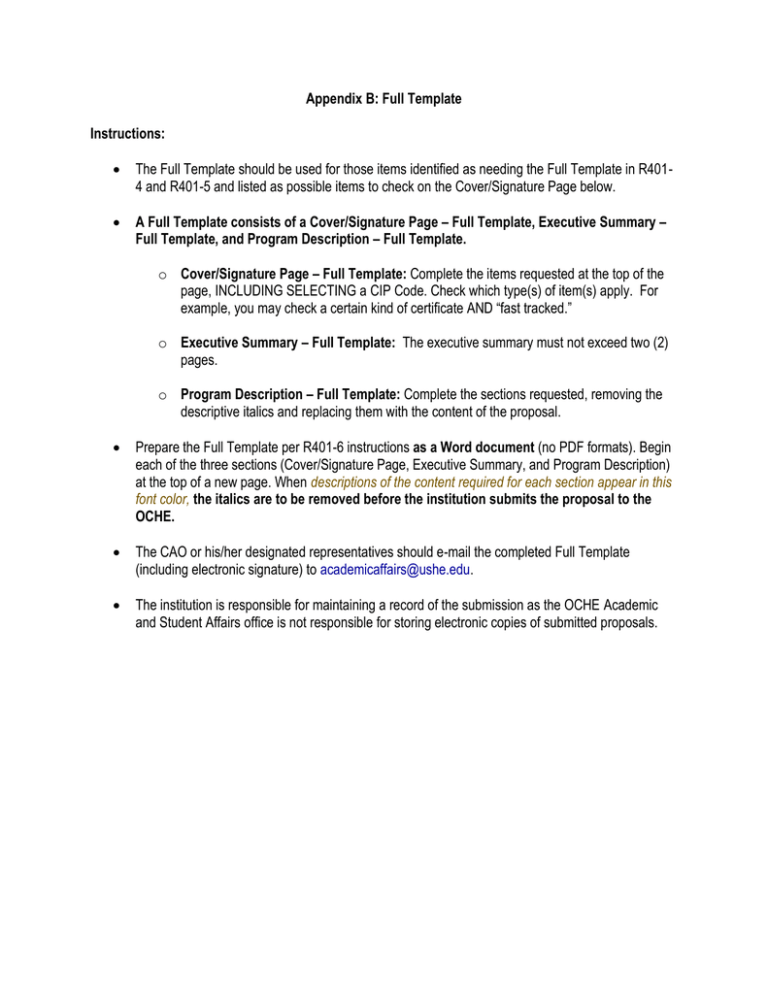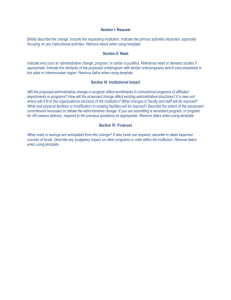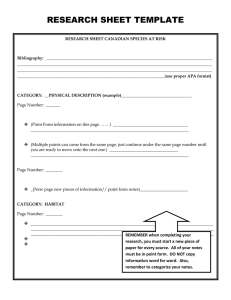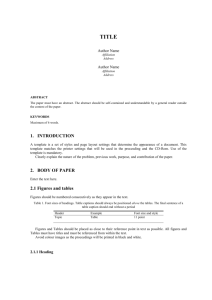Appendix B: Full Template Instructions:
advertisement

Appendix B: Full Template Instructions: The Full Template should be used for those items identified as needing the Full Template in R4014 and R401-5 and listed as possible items to check on the Cover/Signature Page below. A Full Template consists of a Cover/Signature Page – Full Template, Executive Summary – Full Template, and Program Description – Full Template. o Cover/Signature Page – Full Template: Complete the items requested at the top of the page, INCLUDING SELECTING a CIP Code. Check which type(s) of item(s) apply. For example, you may check a certain kind of certificate AND “fast tracked.” o Executive Summary – Full Template: The executive summary must not exceed two (2) pages. o Program Description – Full Template: Complete the sections requested, removing the descriptive italics and replacing them with the content of the proposal. Prepare the Full Template per R401-6 instructions as a Word document (no PDF formats). Begin each of the three sections (Cover/Signature Page, Executive Summary, and Program Description) at the top of a new page. When descriptions of the content required for each section appear in this font color, the italics are to be removed before the institution submits the proposal to the OCHE. The CAO or his/her designated representatives should e-mail the completed Full Template (including electronic signature) to academicaffairs@ushe.edu. The institution is responsible for maintaining a record of the submission as the OCHE Academic and Student Affairs office is not responsible for storing electronic copies of submitted proposals. Cover/Signature Page – Full Template Institution Submitting Request: Name of Institution Proposed Title: Program or Unit Title being proposed School or Division or Location: Name of School/Division Location Department(s) or Area(s) Location: Name of Department/Area Location Recommended Classification of Instructional Programs (CIP) Code1 : 00.0000 Proposed Beginning Date: MM/DD/YEAR Institutional Board of Trustees’ Approval Date: MM/DD/YEAR Proposal Type (check all that apply): Regents’ Agenda Items R401-4 and R401-5 Approval by Committee of the Whole SECTION NO. ITEM 4.1.1 (AAS) Associate of Applied Science Degree (AA) Associate of Arts Degree 4.1.2 (AS) Associate of Science Degree 4.1.3 Specialized Associate Degree 4.1.4 Baccalaureate Degree 4.1.5 K-12 School Personnel Programs 4.1.6 Master’s Degree 4.1.7 Doctoral Degree 5.2.2 (CER C) Certificate of Completion 5.2.4 Fast Tracked Certificate Chief Academic Officer (or Designee) Signature: I certify that all required institutional approvals have been obtained prior to submitting this request to the Office of the Commissioner. ______________________________________ Signature Date: MM/DD/YEAR Printed Name: Name of CAO or Designee 1 CIP codes must be recommended by the submitting institution. For CIP code classifications, please see http://nces.ed.gov/ipeds/cipcode/Default.aspx?y=55. Executive Summary – Full Template Higher Education Institution Degree Type and Title MM/DD/YEAR NOTE: Please limit the Executive Summary to no more than two pages.( Remove these descriptive italics when using template.) Program Description One paragraph description of the program. (Remove italics when using template.) Role and Mission Fit One paragraph statement showing how the proposed certificate or degree is in harmony with the current role and mission of the institution as set forth in Regents’ Policy (R312). (Remove italics when using template.) Faculty State the level of preparedness of current faculty and the level of preparedness that will be needed by the fifth year. Identify the need for additional faculty for each of the first five years of the program. Describe the faculty development procedures that will support this program. (Remove italics when using template.) Market Demand One paragraph giving current data on market demand or the utility of the degree, how the program will accommodate a changing market, and hiring patterns including local, state, and national trends (long-term market needs and numbers to be included). Note that the Department of Workforce Services provides labor market demand data for Utah. It is acknowledged that some degree proposals may be in response to student demand rather than immediate labor market demand. (Remove italics after completing this section of the template.) Student Demand One paragraph giving current student demand, which is demonstrated by student surveys, petitions. Detail potential students’ preparation for the program. (Remove italics after completing this section of the template.) Statement of Financial Support Indicate from which of the following the funding will be generated. Provide the detail for funding as part of the “Financial Analysis” section. (Remove these descriptive italics after completing this section of the template.) Appropriated Fund…………………………………………………. Special Legislative Appropriation………………………………… Grants and Contracts……………………………………………… Special Fees ………………………………………………………. Differential Tuition (must be approved by the Regents)……….. Other (please describe)…………………………………………… Similar Programs Already Offered in the USHE A list of similar programs already approved and functioning at USHE institutions. (Remove these descriptive italics after completing this section of the template.) Program Description – Full Template Higher Education Institution Degree Type and Title MM/DD/YEAR Section I: The Request Name of Institution requests approval to offer Name of Degree effective Semester Year. This program has been approved by the institutional Board of Trustees on Date. Section II: Program Description Complete Program Description Present the complete, formal program description as it will appear in the institution’s catalog. (Remove these descriptive italics after completing this section of the template.) Purpose of Degree State why your institution should be approved to offer this degree and the expected outcomes. (Remove these descriptive italics after completing this section of the template.) Institutional Readiness Describe how the existing administrative structures support the proposed program and identify new organizational structures that may be needed to deliver the program. Describe how the proposed program will or will not impact the delivery of undergraduate and/or lower-division education. (Remove these descriptive italics after completing this section of the template.) Departmental Faculty Using the format below, indicate the headcount of departmental (not program-specific) faculty in each category. In the final row of the chart, provide departmental faculty FTE. “Tenured” includes already tenured and tenure-track. “Non-tenured” includes faculty NOT tenured or on the tenure track. “NonTenured” includes all non-tenured and non-tenure track (including teaching assistants) who provide instruction in the department. Describe in general terms how faculty/instructional staff will be deployed to successfully deliver this program. (Remove these descriptive italics after completing chart below.) Dpt Faculty Faculty Dpt Faculty Headcount – Additions Headcount at Department Faculty Category Prior to to Full Program Program Support Implementation Implementation Program With Doctoral Degrees (Including MFA and other terminal degrees, as specified by the institution) Full-time Tenured Full-time Non-Tenured Part-time Tenured Part-time Non-Tenured With Master’s Degrees Full-time Tenured Full-time Non-Tenured Part-time Tenured Part-time Non-Tenured With Bachelor’s Degrees Full-time Tenured Full-time Non-Tenured Part-time Tenured Part-time Non-Tenured Other Full-time Tenured Full-time Non-Tenured Part-time Tenured Part-time Non-Tenured Total Headcount Faculty in the Department Full-time Tenured Full-time Non-Tenured Part-time Tenured Part-time Non-Tenured Total Department Faculty FTE (As reported in the most recent A-1/S-11 Institutional Cost Study for “prior to program implementation” and using the A-1/S-11 Cost Study Definition for the projected “at full program implementation.”) X Staff List all additional staff needed to support the program in each of the first five years, e.g., administrative, secretarial, clerical, laboratory aides/ instructors, advisors, teaching/graduate assistants. (Remove these descriptive italics after completing this section of the template.) Library and Information Resources Describe library resources required to offer the proposed program if any. Does the institution currently have the needed library resources? (Remove these descriptive italics after completing this section of the template.) Admission Requirements List admission requirements specific to the proposed program. (Remove these descriptive italics after completing this section of the template.) Student Advisement Describe how students in the proposed program will be advised. (Remove these descriptive italics after completing this section of the template.) Justification for Graduation Standards and Number of Credits Provide graduation standards. Provide justification if number of credit or clock hours exceeds 63 for AA or AS, 69 for AAS, 126 credit hours for BA or BS; and 36 beyond the baccalaureate for MS. (Remove these descriptive italics after completing this section of the template.) External Review and Accreditation Indicate whether any external consultants, either in- or out-of-state, were involved in the development of the proposed program, and describe the nature of that involvement. For a career and technical education program, list the members and describe the activities of the program advisory committee. Indicate any special professional accreditation which will be sought and how that accreditation will impact the program. Project a future date for a possible accreditation review; indicate how close the institution is to achieving the requirements, and what the costs will be to achieve them. (Remove these descriptive italics after completing this section of the template.) Projected Program Enrollment and Graduates; Projected Departmental Faculty/Students Using the format below, indicate the projected number of graduates and declared majors expected over the next five years in the new program proposed. Data Category Current – Prior to New Program Implementation PROJ YR 1 PROJ YR 2 PROJ YR 3 PROJ YR 4 PROJ YR 5 Data for Proposed Program Number of Graduates in X Proposed Program Total # of Declared Majors in X Proposed Program Departmental Data – For All Programs Within the Department Total Department Faculty FTE (as reported in Faculty table above) Total Department Student FTE (Based on Fall Third Week) Student FTE per Faculty FTE (ratio of Total Department Faculty FTE and Total Department Student FTE above) Program accreditation-required ratio of Student FTE/Faculty FTE, if applicable: (Provide ratio here:_______________________) Expansion of Existing Program If the proposed program is an expansion or extension of an existing program, present enrollment trends by headcount and by student credit hours (if appropriate) produced in the current program for each of the past five years for each area of emphasis or concentration. (Remove these descriptive italics after completing this section of the template.) Section III: Need Program Need Clearly indicate why such a program should be initiated. (Remove these descriptive italics after completing this section of the template.) Labor Market Demand Include local, state, and national data, and job placement information, the types of jobs graduates have obtained from similar programs. Indicate future impact on the program should market demand change. (Remove these descriptive italics after completing this section of the template.) Student Demand Describe evidence of student interest and demand that supports potential program enrollment. (Remove these descriptive italics after completing this section of the template.) Similar Programs Are similar programs offered elsewhere in the state or Intermountain Region? If yes, cite justifications for why the Regents should approve another program of this type. How does the proposed program differ from similar program(s)? Be specific. (Remove these descriptive italics after completing this section of the template.) Collaboration with and Impact on Other USHE Institutions Describe discussions with other USHE institutions that are already offering the program that have occurred regarding your institution’s intent to offer the proposed program. Include any collaborative efforts that may have been proposed. Analyze the impact that the new program would have on other USHE institutions. (Remove these descriptive italics after completing this section of the template.) Benefits State how the institution and the USHE benefit by offering the proposed program. (Remove these descriptive italics after completing this section of the template.) Consistency with Institutional Mission Explain how the program is consistent with and appropriate to the institution’s Regents-approved mission, roles, and goals. (Remove these descriptive italics after completing this section of the template.) Section IV: Program and Student Assessment Program Assessment State the goals for the program and the measures that will be used in the program assessment procedure to determine if goals are being met. (Remove these descriptive italics after completing this section of the template.) Expected Standards of Performance List the standards and competencies that the student will have met and achieved at the time of graduation. How or why were these standards and competencies chosen? Include formative and summative assessment measures you will use to determine student learning. (Remove these descriptive italics after completing this section of the template.) Section V: Finance Department Budget Include the Financial Analysis form followed immediately by comments if necessary. In the following table project the increased expenses to the institution by adding the proposed program. Three-Year Budget Projection Departmental Budget Current Departmental Year 1 Year 2 Departmental Budget – Prior Addition Addition Data Total Total to New Program to to Budget Budget Implementation Budget Budget Personnel Expense Salaries and Wages Benefits Total Personnel $ $ $ $ $ Expense Non-Personnel Expense Travel Capital Library Current Expense Total NonPersonnel Expense Total Expense $ $ $ $ (Personnel + $ Year 3 Addition Total to Budget Budget $ $ $ $ Current) Departmental Funding Appropriated Fund Other: Special Legislative Appropriation Grants and Contracts Special Fees / Differential Tuition Total Revenue $ Difference Revenue$ Expense Departmental Instructional Cost / Student Credit Hour* (as reported $ in institutional Cost Study for “current” and using the same Cost Study $ $ $ $ $ $ $ $ $ $ $ $ $ $ $ $ $ $ Definition for “projected”) * Projected Instructional Cost/Student Credit Hour data contained in this chart are to be used in the Third-Year Follow-Up Report and Cyclical Reviews required by R411. Funding Sources Describe how the program will be funded, i.e. new state appropriation, tuition, reallocation, enrollment growth, grants or other sources. (Remove these descriptive italics after completing this section of the template.) Reallocation If program is to be supported through internal reallocation, describe in specific terms the sources of the funds. (Remove these descriptive italics after completing this section of the template.) Impact on Existing Budgets If program costs are to be absorbed within current base budgets, what other programs will be affected and to what extent? Provide detailed information. Confidential information may be sent to the Commissioner under seal. (Remove these descriptive italics after completing this section of the template.) Section VI: Program Curriculum All Program Courses (with New Courses in Bold) List all courses, including new courses, to be offered in the proposed program by prefix, number, title, and credit hours (or credit equivalences) The total number of courses shown and credit hours should match the required number of credits to be awarded the degree. Use the following format. (Remove these descriptive italics after completing this section of the template.) Course Prefix and Number Title Credit Hours Required Courses Sub-Total Elective Courses Sub-Total Track/Options (if applicable) Sub-Total Total Number of Credits Program Schedule For each level of program completion, present, by semester, a suggested class schedule—by prefix, number, title, and semester hours. (Remove these descriptive italics after completing this section of the template.) Section VII: Faculty List current faculty within the institution – with their qualifications – to be used in support of the program. Do not include resume or resume material. If new faculty lines are being used for the program, but the faculty member has not yet been hired, so indicate. (Remove these descriptive italics after completing this section of the template.)


